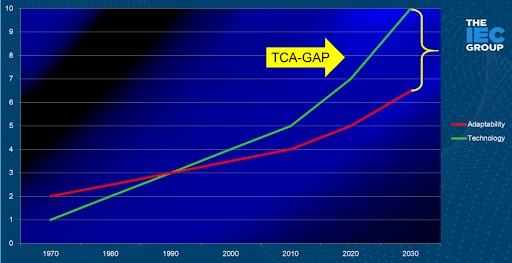Bridging the Digital Divide: Navigating the TCA Gap in the Age of Affordable Technology
n recent decades, the landscape of information technology (IT) has undergone a remarkable transformation, becoming more affordable and innovative at an unprecedented pace.
This evolution has impacted not just enterprises, but also consumers, democratizing access to advanced technological solutions.
Contrary to expectations, however, this rapid advancement in IT has not translated into a corresponding increase in technological adeptness, particularly in the context of organizational digitalization. A noticeable hesitance prevails in embracing these changes.
This resistance raises critical questions: Is it the technology itself, the process of change, a lack of effective leadership, or other factors that contribute to this growing divide?

This phenomenon, known as the Technology Capability-Adaptability (TCA) Gap, highlights the discrepancy between the potential of technology and its actual implementation and acceptance in organizational environments.
Understanding and addressing the underlying causes of the TCA Gap is crucial for leveraging the full potential of IT innovations in the modern business landscape.

The Technology Capability -Adaptability (TCA) Gap is a complex issue, influenced by multiple factors. Understanding these factors is crucial to developing strategies to bridge this gap:
- Resistance to Change: Humans are naturally resistant to change. This can manifest in scepticism towards new technologies, particularly among employees accustomed to traditional methods.
Recommendation: Foster a culture of continuous learning and innovation. Regular training sessions and workshops can help employees become more comfortable and skilled with new technologies.
- Lack of Digital Literacy: A gap in digital skills can hinder the adoption of new technologies.
Recommendation: Invest in digital literacy programs. Tailor training to different skill levels to ensure all employees can confidently use new technologies.
- Inadequate Change Management: Poorly managed digital transformation can lead to confusion and resistance.
Recommendation: Implement structured change management processes. This includes clear communication, setting realistic expectations, and involving employees in the transition process.
- Mismatched Technology Solutions: Sometimes, the chosen technology may not align well with the business’s needs or existing processes.
Recommendation: Conduct thorough needs assessments before selecting technologies. Involve end-users in the selection process to ensure the technology meets their needs and integrates smoothly with existing workflows.
- Leadership and Vision Gap: Leadership plays a crucial role in driving technology adoption. A lack of vision or support from top management can impede progress.
Recommendation: Ensure strong leadership support for digital initiatives. Leaders should actively advocate for and participate in digital transformation efforts.
- Cost Concerns: The initial cost of adopting new technology can be a significant barrier, especially for smaller organizations.
Recommendation: Focus on the long-term ROI of technology investments. Consider scalable solutions that allow gradual implementation to manage costs.
- Security and Privacy Concerns: With increasing digitalization, data security and privacy issues become more prominent, potentially causing reluctance in adopting new technologies.
Recommendation: Prioritize data security and privacy in all digital initiatives. Regularly update security protocols and train employees on data protection best practices.
- Organizational Culture: An organization’s culture can significantly influence its adaptability to new technologies. A culture that is risk-averse or lacks collaboration can slow down technology adoption.
Recommendation: Cultivate a culture that values innovation, collaboration, and calculated risk-taking. Recognize and reward efforts towards digital adaptation and innovation.
- Leadership and Trust in Transition: A significant factor in the TCA Gap is the level of trust employees place in their leadership during the adoption of new technologies, shaped by previous organizational changes that may not have benefited employees.
Quote from a CEO: “In the seventies and eighties, we knew what we wanted to achieve with IT, but often we just couldn’t afford everything. Now, as most technologies are very affordable, we’re faced with a different challenge: we don’t even know where to start, and more importantly, how to take the workforce with us through these changes.”
Recommendation: It’s vital for leaders to build and maintain trust during these transitions. This involves clear communication about the benefits and potential challenges of new technologies, acknowledging past initiatives that didn’t deliver expected benefits, and demonstrating a commitment to employee welfare and professional growth. Leaders must align technological changes with both the organization’s future goals and the individual interests of employees, creating a supportive environment that values their participation in and adaptation to technological change.
- Strategic Ventures and Acquisitions: A viable approach to leveraging breakthrough technology solutions is to consider launching new, agile organizations or acquiring startups that already embody the innovative and technological prowess sought. This not only brings in fresh perspectives and expertise but also can serve as a catalyst for change within the core business. However, it is crucial not to overlook the importance of a long-term strategy for integrating these new ventures with the core business, or deciding strategically when to keep them separate to maximize their potential and impact.
Recommendation: Assign leaders who understand both the startup and the parent company’s culture and can navigate the challenges of merging different organizational styles and workflows. Carefully evaluate and choose startups that not only have innovative solutions but also align with the long-term vision and culture of your core business.
By addressing these factors, organizations can better navigate the challenges of digital transformation and reduce the TCA Gap, leveraging technology to enhance efficiency, competitiveness, and innovation.
Results of the “IEC Wishlist” survey:

Based on the survey results depicted in the bar graph, it’s clear that there are distinct priorities among the respondents regarding the wishlist for technology and adaptability initiatives. The most valued area, with the highest average rating, appears to be “Technological Innovation and Resilience,” followed by “Digital Transformation in Global Business Operation,” indicating that respondents showing a strong interest in not just adopting new technologies, but also ensuring that they contribute to the resilience of the business.
Given the emphasis placed on technology and adaptability initiatives in the survey results, we’ve chosen to prioritize addressing the Technology Capability-Adaptability (TCA) Gap as our foundational step.
This strategic focus ensures that any subsequent initiatives are well-received and effective, essentially preparing fertile ground for the successful integration and implementation of new technologies and adaptive strategies within our organization.
Go To’s: Embrace the challenge of the TCA Gap by actively engaging in a culture of learning and innovation. Prioritize digital literacy, invest in targeted training, and ensure leadership models a commitment to adaptability.
Evaluate and align new technologies with your organization’s unique needs, and approach digital transformation with a structured, inclusive strategy.
Above all, cultivate trust and articulate a clear, compelling vision for technology adoption that resonates with and benefits your entire team.


